
Maria Feodorovna, known before her marriage as Princess Dagmar of Denmark, was Empress of Russia from 1881 to 1894 as the wife of Emperor Alexander III. She was the fourth child and second daughter of Christian IX of Denmark and Louise of Hesse-Kassel. Maria’s eldest son, Nicholas, was the last Emperor of Russia, ruling from 1 November 1894 until his abdication on 15 March 1917. Maria lived for 10 years after Bolshevik functionaries killed Nicholas and his immediate family in 1918.
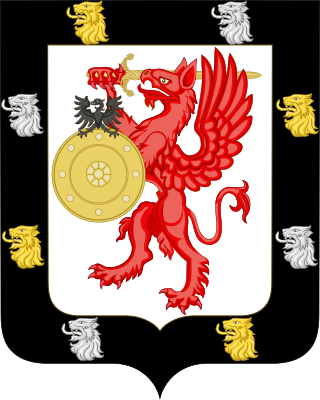
The House of Romanov was the reigning imperial house of Russia from 1613 to 1917. They achieved prominence after Anastasia Romanovna married Ivan the Terrible, the first crowned tsar of all Russia. Nicholas II, the last Emperor of Russia, and his immediate family were executed in 1918, but there are still living descendants of other members of the imperial house.

Catherine IAlekseevna Mikhailova was the second wife and Empress consort of Peter the Great, whom she succeeded as Empress of Russia, ruling from 1725 until her death in 1727.

Elizabeth or Elizaveta Petrovna was Empress of Russia from 1741 until her death in 1762. She remains one of the most popular Russian monarchs because of her decision not to execute a single person during her reign, her numerous construction projects, and her strong opposition to Prussian policies.

Alexandra Feodorovna, born Princess Alix of Hesse and by Rhine, was the last Empress of Russia as the consort of Tsar Nicholas II from their marriage on 26 November [O.S. 14 November] 1894 until his forced abdication on 15 March [O.S. 2 March] 1917. A granddaughter of Queen Victoria, Alexandra was one of the most famous royal carriers of hemophilia and passed the condition to her son, Alexei Nikolaevich, Tsarevich of Russia.

Tsarina or tsaritsa is the title of a female autocratic ruler (monarch) of Bulgaria, Serbia or Russia, or the title of a tsar's wife. The English spelling is derived from the German czarin or zarin, in the same way as the French tsarine / czarine, and the Spanish and Italian czarina / zarina. (A tsar's daughter is a tsarevna.)

Anna Pavlovna of Russia was Queen of the Netherlands by marriage to King William II of the Netherlands. She was a Russian patriot who upheld a strict royal etiquette in the Netherlands, where she never felt at home, and identified more as an Imperial Russian Grand Duchess than a Dutch Queen. She had no political influence, but was active within charity.
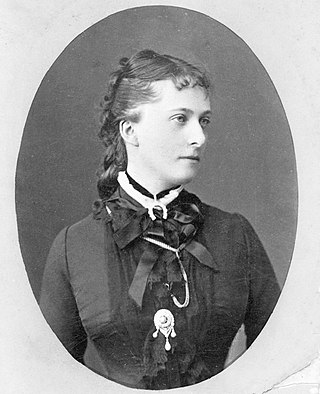
Princess Catherine Dolgorukova was a Russian aristocrat and the daughter of Prince Michael Dolgorukov and his wife, Vera Vishnevskaya.
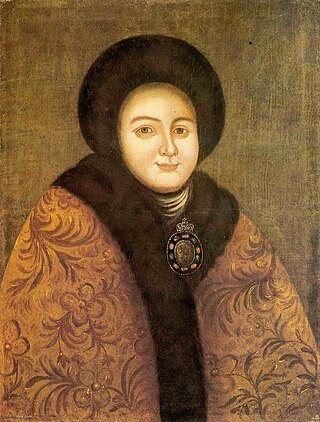
Tsarina Eudoxia Fyodorovna Lopukhina was the first wife of Peter I the Great, and the last ethnic Russian and non-foreign wife of a Russian monarch. She was the mother of Tsarevich Alexei Petrovich and the paternal grandmother of Peter II of Russia.

Natalia Fyodorovna Lopukhina was a Russian noble, court official and alleged political conspirator. She was the daughter of Matryona Balk, who was the sister of Anna Mons and Willem Mons. She is famous for the Lopukhina affair, an alleged conspiracy engineered by the diplomacy of Holstein and France at the Russian court and centred on the person of Lopukhina.
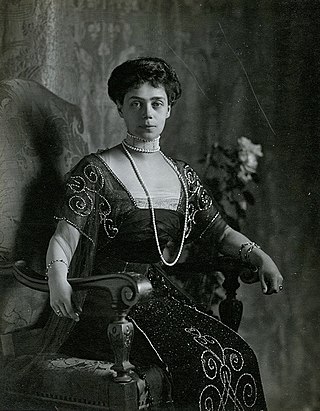
Grand Duchess Xenia Alexandrovna of Russia was the elder daughter and fourth child of Tsar Alexander III of Russia and Dagmar of Denmark. She was the sister of the last Emperor of Russia, Nicholas II.

The coronation of the emperor of Russia from 1547 to 1917, was a highly developed religious ceremony in which they are crowned and invested with regalia, then anointed with chrism and formally blessed by the church to commence his reign. Although rulers of Muscovy had been crowned prior to the reign of Ivan III, their coronation rituals assumed overt Byzantine overtones as the result of the influence of Ivan's wife Sophia Paleologue, and the imperial ambitions of his grandson, Ivan the Terrible. The modern coronation, introducing "Western European-style" elements, replaced the previous "crowning" ceremony and was first used for Catherine I in 1724. Since tsarist Russia claimed to be the "Third Rome" and the replacement of Byzantium as the true Christian state, the Russian rite was designed to link its rulers and prerogatives to those of the so-called "Second Rome" (Constantinople).
The Pauline Laws are the house laws of the Romanov rulers of the Russian Empire. The name comes from the fact that they were initially established by Emperor Paul I of Russia in 1797. Previously drafted privately as a contract between Paul Petrovich while being the heir apparent, and his wife Maria Feodorovna, it was made public and signed into law after Paul succeeded his mother Catherine II in November 1796 and was crowned Emperor.

Prince George Alexandrovich Yuryevsky was the natural son of Alexander II of Russia by his mistress, Princess Catherine Dolgorukova. The morganatic marriage of George's parents on 6 July 1880, eight years after his birth, resulted in the legitimation of their three surviving children, and George gained the style of Serene Highness.

Prince Pyotr Vasilyevich Lopukhin was a Russian politician and member of the Lopukhin family. He was president of the Council of Ministers from 1816 to 1827.

The emperor and autocrat of all Russia, also translated as emperor and autocrat of all the Russias, was the official title of the Russian monarch from 1721 to 1917.

The Spring Flowers egg, sometimes referred to as the Imperial Spring Flowers egg, was considered one of the Imperial Easter eggs attributed to Peter Carl Fabergé. If it is an authentic Imperial egg, then the Spring Flowers egg would have been the first in the series of "flower eggs" and would have been created between 1885 and 1890. It consists of a case made of white maple covered in leather with steel hinges and clasps containing a smaller egg decorated in red enamel and gold scroll work placed upright on a small stand of carved bowenite which then opens vertically to reveal a fully removable bower of flowers made of garnets and white chalcedony in a basket of platinum. The red egg stands 3.25 inches (83 mm) high, and the bower inside it 1.5 inches (38 mm). It was purchased by Russian businessman Viktor Vekselberg in 2004 as part of a collection of such eggs and various other Fabergé items.
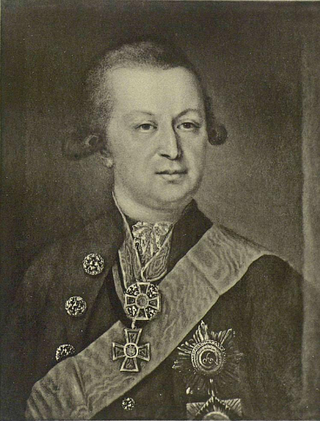
Prince Gavriil Petrovich Gagarin was a Russian writer, senator and minister of the Gagarin family. Active Privy Councillor (1800), under Paul I – member of the Imperial Council, under Alexander I – Minister of Commerce. One of the largest figures of the Masonic movement in Russia.
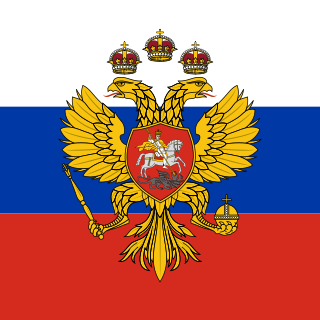
The Tsar of all Russia, officially the Sovereign, Tsar and Grand Prince of all Russia, was the title of the Russian monarch from 1547 to 1721. During this period, the state was a tsardom.
This is a list of notable events from the year 1777 in Russia.


















